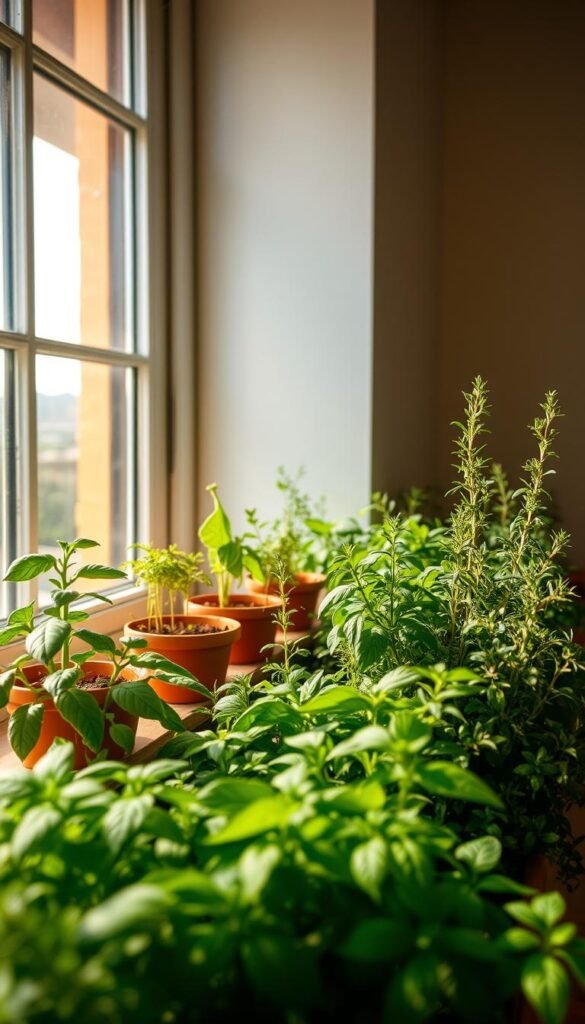Imagine plucking aromatic leaves straight from your living space to elevate meals. Creating a vibrant collection of plants near sunlight lets you enjoy nature’s pantry year-round. This guide reveals how to nurture flavorful greens using simple science and smart placement.
Leaves act like solar panels, absorbing energy through photosynthesis. Blue and red wavelengths fuel growth, while sunlight’s full spectrum creates robust flavors. Most varieties thrive with 4-6 daily hours of direct exposure.
You’ll learn to pick prime spots that balance brightness and convenience. We’ll break down light measurement tricks and container choices for limited areas. Discover why proper positioning helps plants develop richer oils and complex aromas.
From basil’s peppery kick to mint’s cool freshness, your culinary creations will shine. This journey covers setup essentials, maintenance tips, and solutions for common issues. Soon, you’ll harvest ingredients that transform ordinary dishes into chef-worthy meals.
Understanding the Essentials of Indoor Herb Gardening
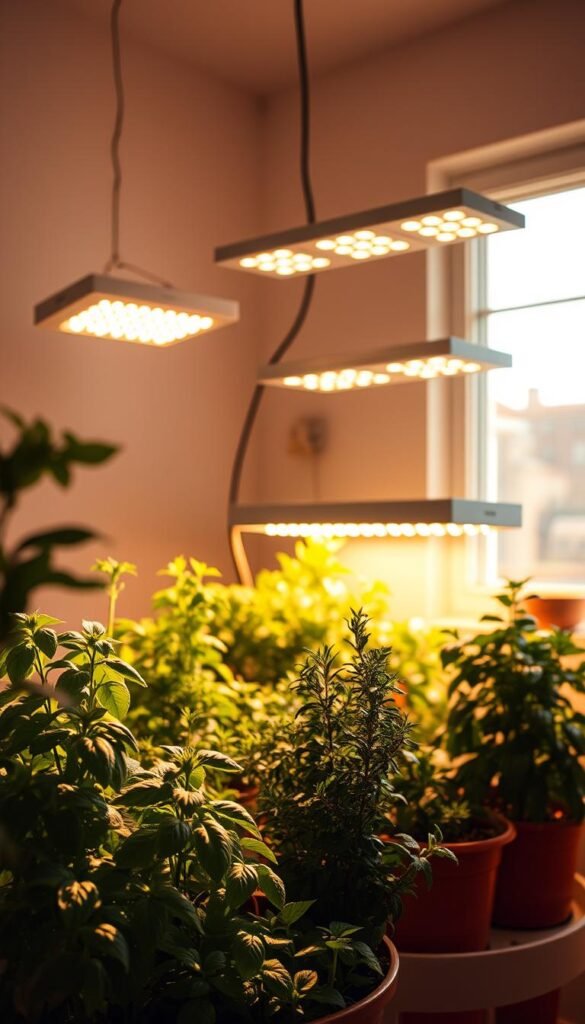
Transform your home into a green sanctuary with thriving potted greens that do more than spice up meals. These living accents offer stress-reducing benefits while keeping fresh flavors at your fingertips. Let’s explore how nurturing greenery indoors boosts both your space and culinary creations.
Why Growing Herbs Indoors Can Enhance Your Space
Caring for leafy companions creates a calming rhythm in daily life. Studies show tending plants lowers cortisol levels by 14% – that’s the stress hormone. For apartment dwellers or those with mobility needs, pots on counters bring nature within reach.
The Role of Natural Light in Herb Development
Sunlight acts like a flavor booster for leafy greens. When rays hit leaves, plants produce protective oils that sharpen tastes and scents. These oils increase by up to 30% under proper light conditions compared to shaded growth.
| Light Type | Effect on Herbs | Key Benefit |
|---|---|---|
| Blue Light | Encourages leaf growth | Lush foliage |
| Red Light | Stimulates flowering | Enhanced aroma |
| UV Light | Boosts oil production | Stronger flavors |
South-facing spots capture the most rays, but east-facing windows work well for morning light lovers like basil. Watch for leggy stems – they’re your plant’s way of begging for more sunshine.
Choosing the Right Location: Windows & Light Considerations
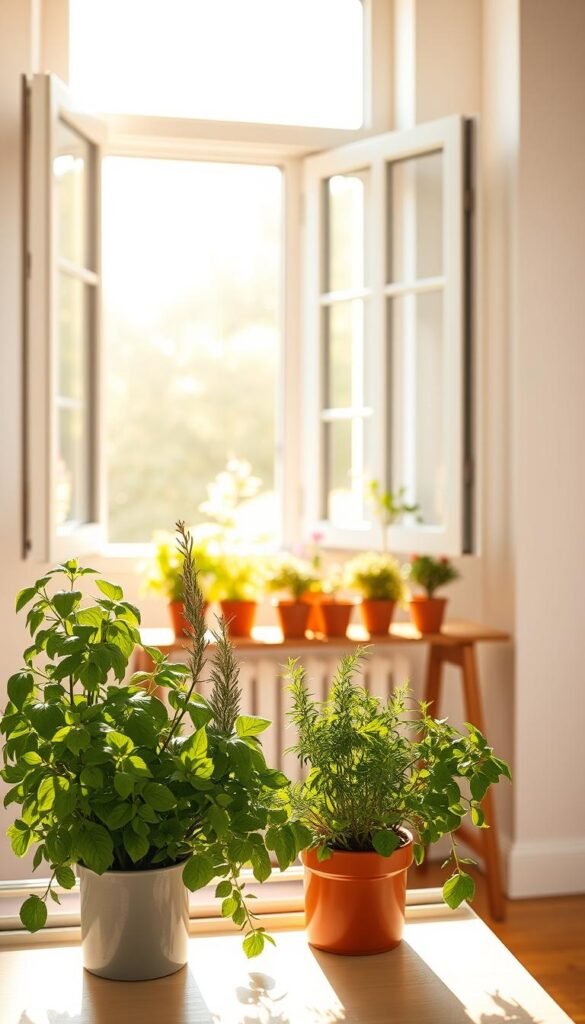
Your home’s orientation determines which leafy companions will flourish. Like real estate, plant placement revolves around three factors: light, light, and light. Let’s decode your window directions to match greenery with their ideal conditions.
Sun Exposure by Compass Direction
South-facing glass areas bathe plants in direct light all day – perfect for Mediterranean varieties. Rosemary and thyme crave this intense exposure, needing at least six hours daily. West-facing spots deliver afternoon rays that basil and oregano adore.
| Window Direction | Light Intensity | Best For | Daily Light Hours |
|---|---|---|---|
| South | Strongest | Rosemary, Sage | 6+ |
| West | Moderate-Strong | Basil, Oregano | 4-6 |
| East | Gentle Morning | Mint, Chives | 2-4 |
| North | Soft Indirect | Lemon Balm | <3 |
Reading Your Plants’ Light Language
When stems stretch like taffy and new leaves stay small, your green friends need more sunlight. This “leggy” growth means they’re reaching for rays. Rotate pots weekly to prevent lopsided stretching.
Check upper leaves monthly. If they pale compared to lower foliage, consider moving plants closer to the glass. Most varieties tolerate being 6-12 inches from panes – just avoid touching cold winter windows.
Window Herb Garden Indoor: Harnessing Natural Light for Happy Herbs
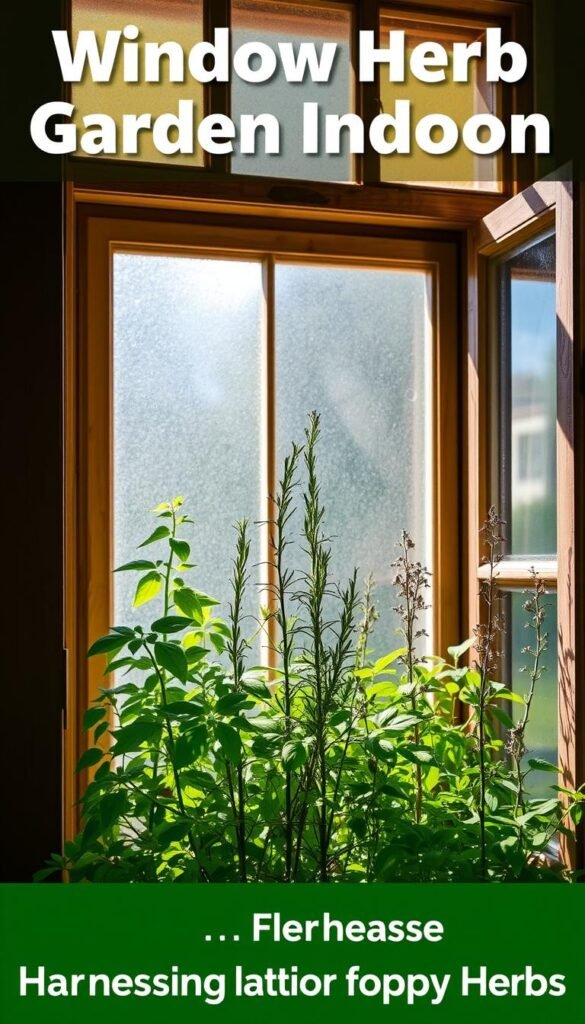
Your window glass acts like a filter shaping your plants’ growth. Modern panes block varying light levels – single-pane glass transmits 90% of sunlight, while energy-efficient options reduce it to 75%. Surprisingly, some growers find low-E windows improve plant health by stabilizing temperatures year-round.
Here’s the sweet spot: most leafy greens need 4-6 daily hours of direct rays. Basil and thyme will grow with less, but their oils intensify when bathed in extra sunshine. Track sunlight patterns using free phone apps to identify prime real estate near your glass.
| Glass Type | Light % | Best For |
|---|---|---|
| Single-Pane | 90% | Light-hungry rosemary |
| Double-Pane | 81% | Versatile oregano |
| Low-E | 75-78% | Cold-sensitive basil |
Arrange taller pots at the back when grouping plants. Rotate containers weekly so all sides receive equal exposure. If stems stretch awkwardly, scoot them closer to the pane – just keep leaves from touching icy winter glass.
East-facing windows work magic for mint lovers, offering gentle morning rays. For west-facing spaces, position trailing varieties like thyme where afternoon sun won’t scorch delicate leaves. Remember: observing your greens’ responses trumps any rigid rulebook.
Setting Up Your Indoor Space for Thriving Herbs
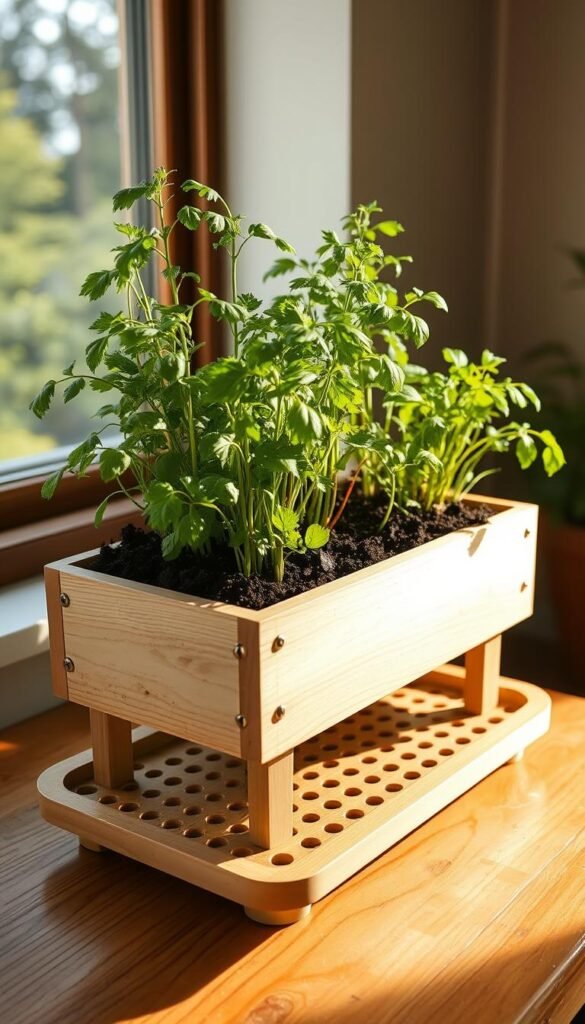
The foundation of every flourishing greenery setup begins with smart container choices and soil science. Let’s explore how to create ideal growing conditions while keeping your living area organized and stylish.
Pot Selection and Earth Mix Essentials
Start with containers that match your plants’ needs. Clay pots breathe better than plastic, while self-watering planters help busy growers. Make sure your potting mix contains perlite or vermiculite – these additives improve airflow and moisture control.
| Container Type | Pros | Cons | Best For |
|---|---|---|---|
| Ceramic | Sturdy, stylish | Heavy | Long-term growth |
| Plastic | Lightweight | Less breathable | Small spaces |
| Terracotta | Natural look | Dries quickly | Mediterranean varieties |
| Fabric | Superior drainage | Frequent watering | Root-sensitive types |
Water Flow and Layout Strategies
Drainage holes prevent soggy roots – aim for at least three quarter-inch openings per pot. Elevate containers on saucers or stands to protect surfaces. Leave 2-3 inches between plants to allow air circulation and growth room.
Group moisture-loving varieties like parsley together, keeping thirstier plants separate. Rotate pots weekly for even sun exposure. Remember: healthy roots need space to stretch – repot when you see roots peeking through drainage holes.
Maximizing Sunlight & Supplemental Lighting Options
Positioning plants isn’t just about space—it’s a science of light distribution. With smart techniques, you can amplify existing rays and supplement when needed. Let’s explore how to create ideal conditions for flavor-packed greens through strategic illumination.
Using Natural Sunlight Effectively on Your Windowsill
Rotate pots 180° every 3 days to prevent lopsided growth. Place light-hungry varieties like rosemary closest to the glass. For beginners growing veggies on a windowsill, these tricks work wonders for herbs too.
Boost natural exposure with:
- Aluminum foil behind plants to reflect 20% more light
- White surfaces below containers to bounce upward rays
- Sheer curtains that diffuse harsh midday beams
When and How to Use Grow Lights for Indoor Herbs
When days dip below 10 hours, add artificial support. Full-spectrum LEDs mimic sunlight best—position them 6-12 inches above foliage. Set timers for 14-hour cycles to maintain growth rhythms.
| Light Type | Daily Use | Best Placement |
|---|---|---|
| Clip-on LEDs | 12-14 hours | Adjustable height |
| Floor Lamps | Morning/evening | Complementary zones |
Watch for leaf curling—it signals lights are too close. Pair afternoon sun with morning lamp sessions for balanced energy intake. Your greens won’t know the difference!
Managing Watering, Feeding, and Grooming Your Herbs
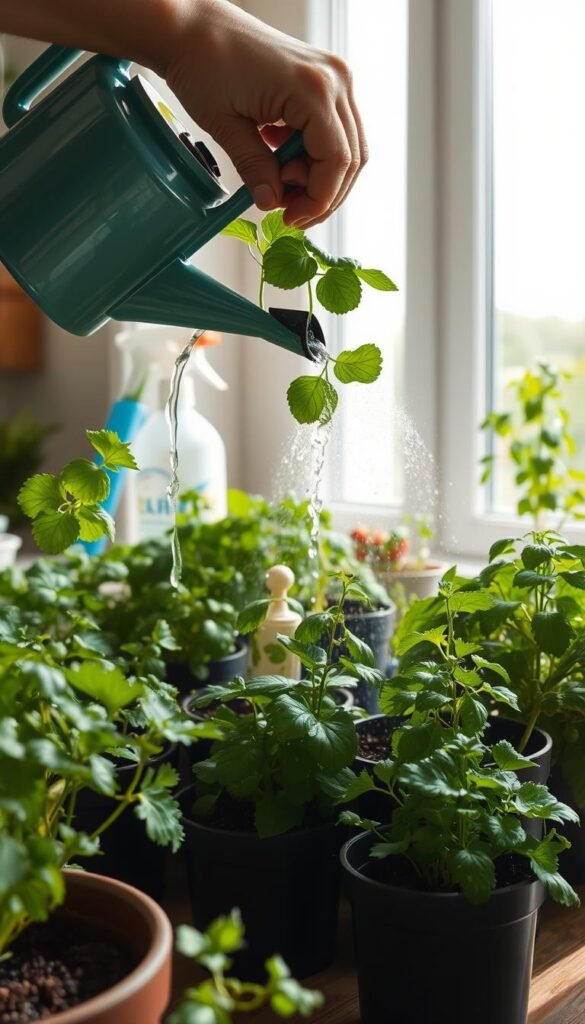
Keeping your leafy companions thriving requires mastering three key skills: hydration, nutrition, and shaping. Let’s explore techniques that keep flavors vibrant and growth consistent.
Best Practices for Watering and Fertilizing
Your plants’ weight tells their thirst level. Lift pots slightly – if they feel light as feathers, it’s watering time. For delicate roots, try bottom-soaking: place containers in 1-inch water baths for 30 minutes. This prevents soil compaction.
| Method | Best For | Frequency |
|---|---|---|
| Can Pouring | Established plants | When topsoil dries |
| Bottom Soaking | Seedlings | Every 5-7 days |
| Misting | Mediterranean varieties | Between waterings |
Feed greens monthly with balanced liquid food (10-10-10 NPK). Overfed plants grow leggy – their stems stretch awkwardly like teenagers. Use half-strength solutions for young specimens.
Tips for Regular Harvest and Pruning
Snip stems just above leaf nodes to encourage bushiness. For basil, pinch flower buds immediately – they steal flavor energy. Always leave ⅓ of growth intact so plants rebound quickly.
Rotate harvest zones weekly. This prevents bald spots and ensures even light exposure. Pair trimming sessions with watering for efficient care – like getting a haircut while sipping tea.
Protect surfaces with trays that catch runoff. This trick works wonders for indoor hanging plants that thrive in sunny too. Wipe leaves monthly with damp cloths – dust blocks their pores.
Adapting to Seasonal Changes: Herbs in Winter and Summer
Your leafy companions need different care as seasons shift. Small tweaks keep flavors bold and growth steady through temperature swings and shifting sun angles.
Protecting Your Herbs from Cold Drafts Near Windows
Winter brings sneaky chills. Move pots 3-6 inches from glass panes when frost hits. Drafty spots can drop leaf temperatures 15°F below room readings. Use clear bubble wrap as temporary insulation between plants and window frames.
Check soil moisture weekly—roots drink slower in cold. Overwatering invites mold. Group plants together to create a humidity buffer. A pebble tray with water adds protection without wetting leaves.
Optimizing Light Exposure During Shorter Days
When daylight dwindles, rotate pots daily for even sun distribution. Place light-hungry varieties like rosemary on elevated stands near south-facing glass. Reflective surfaces like mirrors boost intensity by 18%.
Supplement dim days with LED bulbs for 2-3 morning hours. Keep lights 8 inches above foliage to prevent scorching. Trim leggy stems in January to encourage bushier spring growth.
With these seasonal shifts, your green partners will reward you with vibrant flavors all year. A little observation goes far—plants tell you what they need through their leaves and stems.

